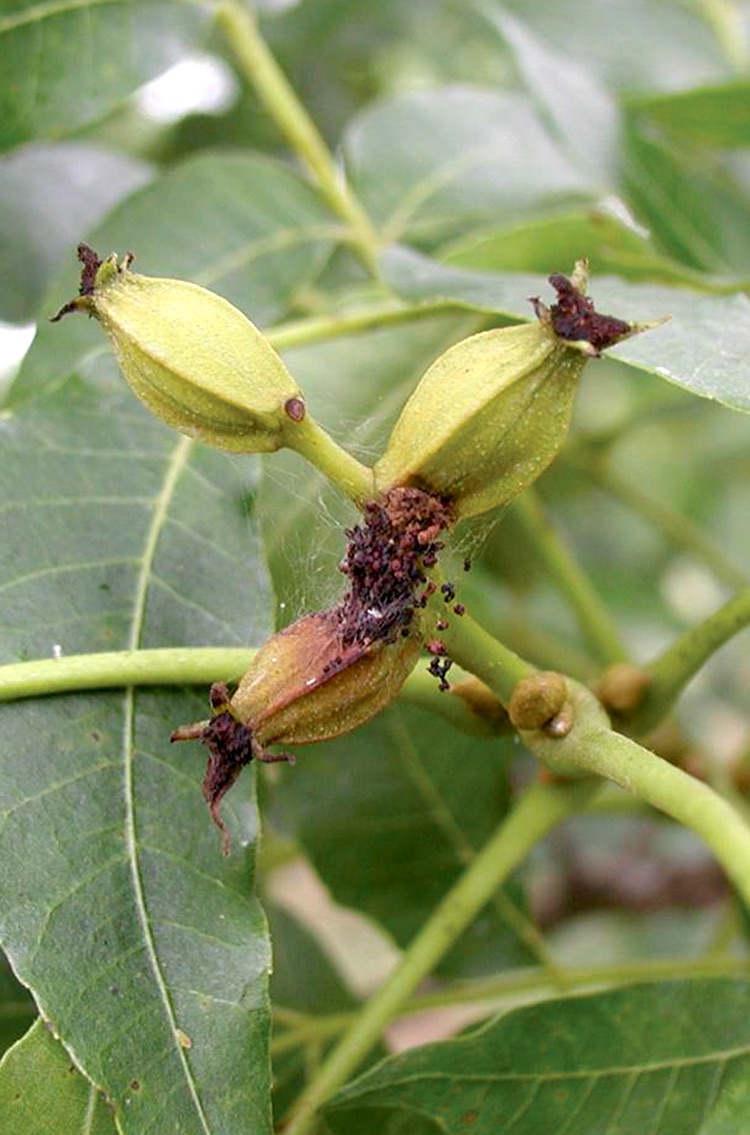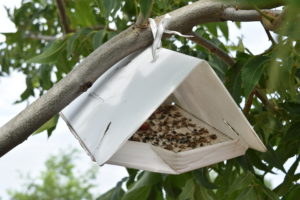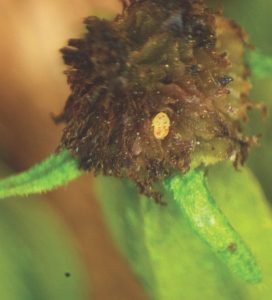Raise your pecan nut casebearer game
The U.S. Environmental Protection Agency discontinued chlorpyrifos usage this February, and the pecan industry loses Lorsban.

This nut cluster exhibits pecan nut casebearer damage. PNC larvae have burrowed into the developing nut; this type of damage is categorized as "nut entry." (Photo by Bill Ree)
Fast forward to the late 1980s, and I was spraying phosalone (Zolone) at the Texas A&M Pecan Orchard. Zolone was hands down the product of choice at the time for pecan nut casebearer control. Zolone persisted on the leaf, stem, and fruit surface longer than other available products, which mattered greatly with PNC. First generation PNC moths normally emerge over a two-week span in April and May, depending on temperature and rainfall. Unseasonably cold spring nights and rain delays stagger moth emergence over more days, which hampers knowing when and how many times to spray. Zolone controlled adult PNC moths and hatching larva over a longer window of time with a single application which made for successful outcomes against a challenging, crop-destroying pest.
Zolone’s label registration for pecans was dropped 34 years ago in 1988. All registrations would eventually be permanently canceled by U.S. Environmental Protection Agency (EPA). As a graduate student in 1988, I recall an “emergency” conference call led by Dr. Marvin Harris, Professor of Entomology and world expert on PNC, who offered up the insecticide options to replace Zolone. Leading his list was chlorpyrifos, trade name Lorsban (several generic trade names available today), my old retail garden center product. Lorsban then became the next best PNC insecticide because of its persistence compared to other chemicals and its lower hazard to humans compared to, say, azinphos-methyl (Guthion). Thus, began a 30-plus year era of Lorsban and its generic equivalents being an important insecticide in the pecan industry for control of PNC, as well as black and yellow aphids, phylloxera, hickory shuckworm, and other pests.
The chlorpyrifos usage era ended on February 28, 2022, when EPA enacted its final rule discontinuing any tolerances for food crops treated with the chemical. The ruling’s language can be found at Regulations.gov. My understanding is that existing supplies of chlorpyrifos can no longer be legally used on food. Although it concerns me that there are “environmental advocacy groups” that operate with no regard for the needs of the food production community, I don’t otherwise have an opinion on the rightness or wrongness with the EPA’s decision on chlorpyrifos. It is what it is. The loss of the tool is not good for the pecan industry per se, but it comes at the best possible time for the pecan industry.
Dr. Harris and his colleagues in Texas, including Allen Knutson, Bill Ree, the late Mark Muegge, and their cooperators, ushered in an even more important tool for PNC a short time after Zolone was dropped—the pheromone trap. I won’t attempt to appropriately credit who synthesized the PNC pheromone lure, who devised the technology to impregnate it in a piece of rubber enabling it to emit the pheromone and be sought out by male PNC moths, or who worked out the nuts and bolts of trap design, tree position, number of traps per orchard, etc. Suffice it to say that a team of people deserve what should be the equivalent of a Nobel Prize for pecan entomological science. It works. We can bring male PNC moths to a spot in the orchard and, thus, know the date they have begun their annual quest for mating and destruction of a pecan crop by their female counterparts.
The loss of chlorpyrifos as a PNC control tool means that pecan growers will have to “raise their game” for managing the pest going forward. Note that chlorpyrifos has not been the top insecticide for PNC control among most pecan growers since around 2004. That designation has largely been methoxyfenozide (trade names: Intrepid 2F, Zylo, Invertid 2F, VEXER; TURNSTYLE), a lepidopteran-specific larvicide that works through hormonal disturbance. It’s safer for the environment and people that work in a pecan orchard. It does not impact beneficial insect populations, so aphid flares don’t happen as a result of spraying it. Methoxyfenozide also has long residual activity, giving growers some “cushion” if they spray a little too early. What’s not to like?
Methoxyfenozide only kills feeding larva. It has no action against adults, so the adults will have their egg-laying party to their maximum capability. The chemical must be ingested by minuscule hatching caterpillars to stop them from feeding. Pecan nut casebearer larvae are known to move from the nutlet hatch site to crevices alongside buds, where they feed for a short time and then move back to the nutlets to develop and pupate. If the larvicide is not deposited on the precise area where they feed, they will not be controlled. Coverage of the chemical on the protected plant surface must therefore be thorough. Wind or anything that impedes coverage will cause reduced control. Methoxyfenozide has good persistence after spraying. It is not a good option for growers who fall behind the insect’s population buildup. Chlorpyrifos was useful in those situations. Having said all this, I do like methoxyfenozide, and it remains our most important insecticide for PNC today, but the loss of chlorpyrifos is a reminder that our IPM program for PNC is more important than ever.
How can pecan growers raise their PNC game?
Generation Monitoring with Traps and Degree Day Models
Although there are three, sometimes four generations of pecan nut casebearer in a single growing season, the first spring generation of PNC is often the most damaging. In Texas, the damage period is usually May 7 or later in the southern region and May 21 or later in the north, with lots of variability between years according to weather. PNC overwinters as larvae in protective structures, called hibernacula, camouflaged on tree trunks and limbs. Pupation and emergence of adult moths coincide with the start of the pecan growing season. Two science-based practices apprise a pecan grower of the biological activity of PNC from emergence to egg laying to nut entry.

A Pecan Nut Casebearer pheromone trap hangs on a young tree during the summer in Oklahoma. (Photo by Catherine Clark)
Most pecan growers today are familiar with pheromone traps. They consist of a sticky trap and a lure. Three to five traps are recommended for orchards less than 50 acres, and 5 to 10 traps should be well distributed in larger orchards. The best use of the traps is to “biofix” the start of the moth flight; therefore, the traps should be out before any chance of moth emergence. The first week of April is a safe date window to set out traps on easily accessed terminal branches. Watch them daily. No more than two days should lapse between checking traps to get the correct date of two consecutive days of moth capture in the traps, which is the critical biofix date. Continue noting trap captures to look for the peak. Moth emergence follows a normal distribution curve in most years. It helps to know both the start and the high point of moth flight activity because your pesticide application must cover the start and the high point of egg laying activity.
Before pheromone traps were developed, Dr. Harris and colleagues developed a degree-day model that predicted PNC activity. The model uses an average daily temperature base of 38 degrees Fahrenheit. When the average daily temperature exceeds 38 degrees F, degree days accumulate that can be used to predict the development of the PNC moth from emergence through egg lay and nut entry. PNC develops faster in years with above-average day and night temperatures.
Pheromone traps came along and increased the resolution of when to start the degree day calendar. Knutson and Muegge (2010) incorporated trap capture data with a degree-day model, and that product has been developed into a forecast tool that gives site specific dates for 10, 25, 50, 75, and 90% oviposition. That grower tool was previously hosted on the ipmPipe and PNCForecast websites and is now found here. The combination of pheromone traps and degree-day models should leave no one guessing when the threat of PNC happens.
Scouting and Crop Assessment
The capture of PNC male moths in pheromone traps is not a predictor of potential crop injury. It is a timing device. We can expect female moths to begin laying eggs 12 to 16 days after the biofix date, but many things can happen to alter their progression and impact on the pecan crop. Weather has already been mentioned as a variable. Orchards in the same county may have mesoclimatic differences that alter the oviposition a few days. Beneficial insects may also play a role in limiting the number of hatching eggs and feeding larva in one orchard versus another. Scouting is key to making the right treatment decision, and scouting should be done in earnest when 25% or more of the eggs are projected to be laid.
PNC scouting is an attempt to find eggs and/or hatched larva on enough clusters of pecans to damage a significant portion of the crop. While scouting for PNC, it’s also important to scout the crop. Exceptionally heavy crops (those having 80% or higher terminals bearing nuts) can benefit from nut thinning by an insect pest. Light to moderate pecan crops should adhere to the conservative action threshold of two or more infested clusters in less than 310 clusters (0.6% infestation rate), triggering an insecticide spray to prevent 5% or higher crop injury.
Scouting PNC is not easy. Few people can see the eggs with their naked eye; most need a 10X magnifying lens. Larva may be found feeding inside or outside the nutlet. Those inside the nutlet are classified as “nut entries.” First generation PNC larvae tend to damage most if not all of the nuts in each infested cluster. Retired AgriLife Entomologist Bill Ree excelled at PNC scouting in part by marking clusters as he found eggs and larva, noting their stage of development, position, and so forth to serve as a means to evaluate insect progress and effectiveness of any insecticide treatments.
Re-scouting after spraying is equally essential to initial population scouting to identify any breakdowns in control and need for a second application.
Sprayer Calibration and Product Rates
I can’t stress enough that when using a larvicide to control PNC like methoxyfenozide (Intrepid 2F, Zylo, Invertid 2F, VEXER; TURNSTYLE), spinetoram (trade names: Delegate and Entrust), diflubenzuron (trade names: Dimilin, Durant, Micromite; UNFORGIVEN), tebufenozide (trade name: Confirm) or Bacillus thuringiensis strains (trade names: Javelin, Deliver, Crymax; Leprotec) that product coverage and rate of active ingredient per acre is very important. I covered sprayer calibration in Pecan South’s March 2021 issue and will summarize here by simply saying one size does not fit all.
Fit the spray output to the tree to cover it well. Alter ground speed and nozzle configuration for different size trees in the orchard. Evaluate coverage with spray sensitive cards to ensure that pesticide droplets make their way to the clusters. Hit or miss coverage will result in excessive PNC nut damage with larvicides.
Inflation in the cost of agrochemicals and fertilizers will tempt some growers to reduce product rates. I believe pest management and irrigation are the two most important facets of annual pecan crop management—not areas to cut cost. Evaluate pesticide label rates carefully, and don’t experiment on your own crop with the lowest possible rate in the range. Talk to Extension specialists, chemical company sales reps, pesticide dealers, and other growers with experience to gain insight on the appropriate rate. The volume of foliage and fruit per acre in heavy crop years is easy to underestimate.
I like the following wording on the Intrepid 2F label by Corteva: “A higher rate range may be required for extended residual effectiveness, higher pest infestations, low crop load, larger trees, or heavy dense foliage.” With the appropriate rate selected, sprayer operators should know how much product to put in a full or partial tank load, so again we come back to the importance of calibration. Know how many gallons of spray solution are applied to each acre of pecan trees.
Emerging Insecticide Choices
Lepidopteran-specific insecticides have the most upside for PNC control and pecan orchard management by reducing disruption of the beneficial insects that have built up in the orchard for several months. Spinosad and Bt offer those benefits but have been historically less effective than methoxyfenozide, due to their shorter residual activity. Diflubenzuron (Dimilin, Durant, Micromite; UNFORGIVEN) has had historically variable results for PNC control, so the choices for today appear to be few. Yet there are new products with potential. A CDMS.net advanced search for insecticides labeled for pecan nut casebearer returned 113 tradename products. I scanned through these discarding the chlorpyrifos, carbaryl (Sevin), malathion, phosmet (Imidan), pyrethroids (bifenthrin, zeta-cypermethrin, etc.), Group 4-type products with translaminar activity that are primarily aphicides, as well as the larvicides previously discussed in this article, which eliminated about 104 products. What remained as alternatives included the following:
- Chlorantraniliprole (Altacor, Vantacor)-Group 28—Targets Lepidoptera pests via ingestion; minimal impact on beneficial insects. Known efficacy on grasshoppers.
- Cyclaniliprole (VERDEPRYN, Minecto Pro)-Group 28—Similar to chlorantraniliprole with feeding cessation and paralysis of both larva and adult stages. Minecto Pro is co-mixed with abamectin, which has activity against certain mites and leaf miners. Listed on the University of Georgia’s Pecan Spray guide for PNC control (B 841_11.PDF (uga.edu)).
- Tolfenpyrad (Apta, Bexar)-Group 21A—Broad-spectrum insect and mite control; likely impacts beneficial insects but offers a different mode of action against target pests. Listed for PNC control on UGA Pecan Spray Guide.
- Chromobacterium subtsugae strain PRAA4-1t and spent fermentation media (Grandevo WDG, Grandevo CG)—Organic microbial biopesticide; demonstrated control on Pecan Weevil in Georgia.
- Heat-killed Burkholderia spp. Strain A396 cells and spent fermentation media (Venerate XC)— Organic microbial biopesticide product with activity via direct contact and ingestion of labeled pecan pests, including fall webworm, hickory shuckworm, and pecan nut casebearer.
I know little about any of these products, but with the loss of an old, stand-by product in chlorpyrifos, it’s a good time to learn. Pesticide diversity is good for growers. Population growth and increased environmental concerns, coupled with a shrinking agricultural community, will put pressure on EPA to continue to eliminate older, broad-spectrum pesticide chemistries in favor of products that are selective and less impactful to human health and the environment. We’re fortunate to have a great IPM foundation for pecan production, and we need to continue to support it with product efficacy trials that provide diverse options for controlling pecan nut casebearer and a wide array of fruit and foliage pests that are not going away.
Note: Use of trade names in this article is for educational purposes only and does not imply product endorsement. Omission of trade names for a particular chemical common name given was unintentional.


